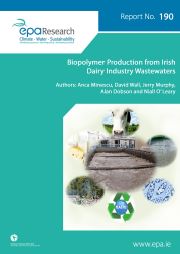Authors: Anca Minescu, David Wall, Jerry Murphy, Alan Dobson and Niall O’ Leary
Summary: This report examines issues surrounding non-sustainable plastic production, use and disposal and highlights the challenges associated with limited commercial uptake of wholly biodegradable polymers.

This report examines issues surrounding non-sustainable plastic production, use and disposal and highlights the challenges associated with limited commercial uptake of wholly biodegradable polymers. The report also examines dairy processing wastewater in the context of a rapid expansion in Irish milk production/processing following the 2015 removal of quotas. These pressures inform the research undertaken in this study, which sought to demonstrate the use mixed microbial cultures to produce commercially significant bioplastics from dairy processing wastewater feedstocks.
This research successfully demonstrated the technical feasibility of polyhydroxyalkanoate bioplastic accumulation from real-time dairy processing wastewater in a laboratory setting. The broader implications of status quo, trade waste practices versus dairy wastewater valorisation opportunities are also presented together with recommendations for future research focus and the merits for pilot scale trials. Life cycle analysis of the laboratory process identifies key hurdles to commercialisation in addition to limitations in data collation from industry r.e. comprehensive cradle to grave sustainability modelling. In summary, this study offers broad, cross-policy significance as it integrates waste to feedstock reclassification, environmentally sustainable material provision, petrochemical polymer replacement and non-renewable CO2 displacement.
This study identified optimised operational parameters for an aerobic dynamic feeding reactor strategy to achieve microbial bioplastic accumulation from dairy processing wastewater feedstocks. Polyhydroxybutyrate was the primary biopolymer generated, but the observation of additional, commercially significant co-polymers suggested further opportunities to develop the process further. Energy profiling and extrapolations of process scale up identified a clear need for pilot scale trialling of the system in order to advance the technology readiness level and facilitate comprehensive demonstration of commercial viability and sustainability.
https://www.epa.ie/media/epa-2020/publications/research/thumb190[1].jpg